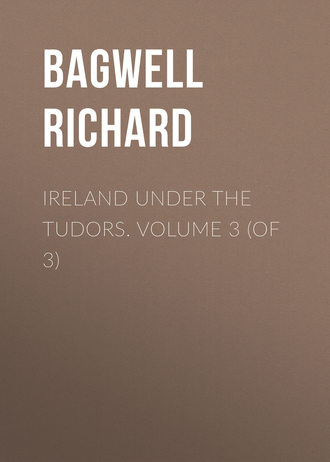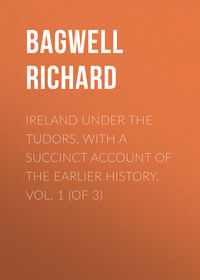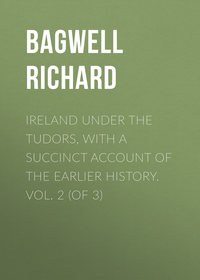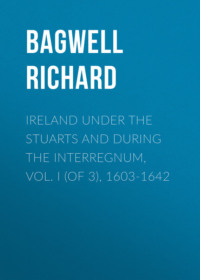 полная версия
полная версияIreland under the Tudors. Volume 3 (of 3)
90
Grey to the Privy Council, April 12, 1582; to Walsingham, May 7; a friend to Mrs. Nugent, July 5, 1583; Sidney’s Brief Relation, 1583. Sir Robert Dillon, who succeeded Nugent as Chief Justice, was much blamed for his conduct in this case; see his letter to Walsingham, June 25, 1582.
91
John Nugent’s confession, February 5, 1582; petition to Burghley, September (No. 85); Ormonde to Burghley, May 30, 1583; Janet Nugent’s petition, August 30; warrants for the remission of her fine and for restoration to her property, April 18, 1584. It is stated that the fine was imposed on the information of John Cusack. William Nugent left Ireland in or before January 1582.
92
Grey to Walsingham, May 7, 1582; Mr. Rawley’s opinion, October 25. Ormonde’s appointment was announced on December 3.
93
The Bishop of Ross to the Lords Justices, October 9, 1582, with remarks by the Lords Justices; Auditor Jenyson to Burghley, September 4; St. Leger to Burghley, September 22, and to the Lords Justices, September 26; the Portreeve of Cashel to the Lords Justices, September 28.
94
Letter from Onor Cartye enclosed in one from the Lords Justices to Walsingham, October 3, 1582; St. Leger to Burghley and Walsingham, September 22.
95
Maltby to Walsingham, June 21, 1582; Clanricarde to Maltby, July 7; Fenton to Leicester, August 13; to Walsingham, August 23. The award is in Carew, under November 17.
96
Barnaby Gooche to Burghley, August 27, 1582; Justice Meade to the Lords Justices, October 13; Lord Justice Loftus to Burghley, November 5; Lords Justices to Burghley, December 8; Spenser’s State of Ireland.
97
St. Leger to Fenton, October 31; to the Queen and to Burghley, November 26, 1582; Burghley to Loftus and Fenton, and to St. Leger, December 9; St. Leger to Burghley and Walsingham, February 2, 1583.
98
Earl of Ormonde’s demands, &c., November 1582; Walsingham to Wallop, December 6; Burghley to the Lords Justices, December 8; Rate for 1,000 men to be sent into Munster, December 15; Lords Justices to Burghley, January 5, 1583; Ormonde to Walsingham, January 27; Wallop to Walsingham, February 7 and March 6; Minute for the Lords Justices, March 5; Ormonde to the Lords Justices, March 20. Ormonde left London, or Windsor, December 22, and landed at Waterford (viâ Milford) January 21, having been long hindered by storms.
99
St. Leger to Burghley, Oct. 29, 1582, and Jan. 16, 1583; and to Walsingham, Feb. 11.
100
G. Fenton to Burghley, Feb. 24, 1583; Ormonde to the Privy Council, Feb. 28 and April 5; to the Queen, April 24; to the Privy Council and to Burghley and Walsingham, May 28; to the Lords Justices, June 15; to the Queen, June 18; to Walsingham, June 22; Thomas Mynne to Wallop, April 9.
101
G. Fenton to Walsingham, Jan. 16; St. Leger to Walsingham, Feb. 11; Sir W. Stanley to Fenton, May 25; Desmond to Ormonde, June 5; Ormonde to Burghley and to the Queen, June 18; to Burghley, June 22.
102
St. Leger to the Queen, May 8 and Aug. 5 (the latter was intercepted); to Burghley, Aug. 5 and Oct. 19; to Walsingham, Aug. 5, 1583, and Sept. 14, 1584; Ormonde to Burghley, Oct. 20, 1583; to the Privy Council, Jan. 23, 1584; to Burghley, Jan. 26, 1584; Walsingham to Ormonde, March 25 and June 12, 1583; Lords Justices to Walsingham, June 18, 1583; G. Fenton to Walsingham, May 30, 1583. The tone of all Wallop’s and Fenton’s letters is unfriendly to Ormonde.
103
Ormonde to Burghley and to Walsingham, July 10, 1583. The nobles and gentlemen who came to Ormonde at Cork and gave pledges were as follows: – Earl of Clancare; Lords Barrymore, Roche, Kinsale and Lixnaw; Sirs – Thomas of Desmond, Owen MacCarthy Reagh, Owen O’Sullivan, Barry Roe, Lord Lixnaw’s son Patrick, the White Knight, Patrick Condon, the seneschal of Imokilly, Cormac MacDermot, nephew to Sir Cormac MacTeig, Callaghan MacTeig MacCarthy, brother to Sir Cormac MacTeig, O’Sullivan More, Donell, nephew to Sir Owen O’Sullivan, O’Donoghue More (inhabiting in MacCarthy More’s country), O’Donoghue of Glenflesk, MacDonogh MacCarthy of Duhallow, O’Keefe, MacAuliffe, O’Callaghan, MacFynnyne, William, brother to the Knight of Kerry, Thomas Oge, seneschal of Kerry, Donogh MacCragh (a rhymer), and divers captains of gallowglasses of the MacSwineys and the MacSheehy’s.
104
St. Leger to Burghley, Aug. 5 and Oct. 19, 1583; N. White to Burghley, Aug. 24; Ormonde to Burghley, Sept. 4 and 23 (the latter enclosing Lord Roche’s letter); Privy Council to Ormonde, Sept. 19.
105
I have followed the strictly contemporary account printed by Archdeacon Rowan in the Kerry Magazine (Jan. 1854), and reprinted by Miss Hickson in Old Kerry Records. No other account is so full, and it is easily reconciled with the Four Masters and with Ormonde’s letters printed by Mr. Gilbert in vol. iv. of the Irish National MSS, and see Ormonde to Walsingham and Burghley, Nov. 28, and Smith’s Cork.
106
The spot where Desmond fell is on the right bank, rather low down in the glen. No doubt the cabin where he spent the night was higher up. In the survey made by Sir Valentine Browne and others, and privately printed by Mr. S. M. Hussey, is the following passage: ‘A great wood here and there, filled with oak-trees fit for house timber, but not large enough for the making of ships and castles. But the greater part of the said wood consists in underwood of the age of fifty and sixty years, filled with dotted trees – ash, hazels, sallows, willows, alders, birches, white-thorns and such like… The wood is called Glanageenty, in which the late Earl of Desmond was slain in his rebellion, containing in length about four miles, and in breadth two miles, which said woods, because no woods there are saleable, and they lie under the mountains of Slew-Logher, far from any river or navigable stream, are here valued at nil.’ I inspected the ground in June 1883.
107
Birch’s Memoirs, i. 27; Ormonde to Burghley, Jan. 26, 1584; Lords Justices to Ormonde, Dec. 31, 1583.
108
Second examination of Christopher Barnewall, Aug. 12, 1583.
109
The text is taken from the official correspondence, Lords Justices to Robert Beale, Oct. 8, 1583; to Walsingham, Oct. 20, Dec. 10, March 7 and 8, 1584, April 14, and July 9; Walsingham to the Lords Justices, April 28, 1584. It appears from the Catholic accounts that combustibles were poured into the boots. That of the Jesuit Holing, who died in 1599, may be taken as contemporary; it is printed in Spicilegium Ossoriense, i. 87. ‘Tormenta nova illi parantur; nam ejus pedibus atroces hæreticorum ministri ocreas, butiro, oleo, et sale oppletas, ac – quod longe crudelius fuit – crudo ex corio conditas subjecerunt; postea, vero, catenis simul et compedibus alligatum, aperto in loco, nempe in medio castri – ubi spectaculum mundo, hominibus, et angelis – ubi ab omnibus videri potuit, lento igne apposuerunt, illicque detinuerunt, donec ipso corio consumpto, butiro, oleo, et sale ferventibus, ossa non cute pro carne tecta verum etiam omnino munda fuerint relicta… Postea in ergastulum et obscurissimum carcerem reducitur, et post sex menses tanquam traditor et reus criminis læsæ majestatis, ab iniquo judice ad mortem condemnatus est. Ad extremum, post inaudita tormenta et carceris molestias, albescente cælo, ne forte tumultus fieret in populo qui ejus exemplo, doctrina, et constantia permotus ad ejus defensionem perveniret, ignorantibus civibus patibulo suspensus martyrium consummavit Dublinii circa annum 1585, mense Maio.’ Other accounts, which agree in essentials, are collected in Brady’s Episcopal Succession, ii. 11, 599. The Valicellian MS. there quoted, says a withen rope was used to protract his agony; but Bacon tells us that this kind of halter was generally used in Ireland, and that a rebel objected to any other.
110
Ormonde to the Privy Council and to Burghley, Jan. 11, 1584, with enclosures; Wallop to Walsingham, Jan. 21.
111
John Browne to Hatton and Walsingham, Nov. 19, 1583; Clanricarde to the Privy Council, Jan. 31, 1584; Lords Justices to the Privy Council, March 28, 1584; Wallop to Leicester, Jan. 26, 1581, in Wright’s Elizabeth. The Four Masters bear out Browne’s statement as to John Burke’s popularity; see also a damaged paper calendared under Nov. 1583 (No. 99). The Earl’s pardon passed the Irish Council, June 28, 1584. Lady Mary married O’Rourke. ‘That honest woman,’ Bingham wrote some years later, ‘is deceased in childbirth’ (to Gardiner, June 10, 1589).
112
Lords Justices to the Privy Council, Sept. 12, 1583. Fenton to Leicester and Warwick, Sept. 13, in Carew; Hooker. This is one of the last, if not the very last trial by combat in the British Islands. Lord Reay’s case, in 1631, is in Howell’s State Trials, vol. iii., with a minute account of the ridiculous ceremonies proper to such a mode of trial; but in that case the fight did not actually take place.
113
Reasons of Brian MacGilpatrick O’Connor &c. (translated out of Irish), Oct. 15, 1583. The brothers seem to have subsided, or as some would say risen, into farmers.
114
The memorial of the Privy Council and the Queen’s instructions are both printed in Desiderata Curiosa Hibernica; see also Perrott’s Life, and Ormonde to Burghley, March 13, 1584. Perrott landed at Dalkey, June 9, and was sworn in by Loftus in St. Patrick’s on the 21st.
115
Ormonde to Burghley, March 13, 1584 (from Carrick); docquet of letter, April 4; Ormonde to Burghley, May 19 (from Abermorles); June 4, (from Carew).
116
Order for a hosting, June 22, 1584; Wallop to Walsingham, July 9; Fenton to Walsingham, July 10.
117
Henry Sheffield to Burghley, July 12, 1584; Memorial for Mr. Edward Norris, Aug. 6; Bingham to Burghley, Aug. 7.
118
William Johnes to Walsingham, July 14, 1584.
119
Perrott’s Memorial for Mr. Edward Norris, Aug. 6, 1584.
120
Wallop to Burghley, Sept. 17, 1584; to Walsingham, Oct. 14 and Dec. 4; Sir V. Browne to Burghley and Walsingham, Oct. 18; to Walsingham, Dec. 11; Waterhouse to Walsingham, Nov. 28; Lord Thomond to Burghley, July 14, 1585; Vice-President Norris to Perrott, Dec. 30, 1585.
121
Fenton to Burghley, Aug. 19, 1584; Perrott to the Privy Council, Aug. 21; Bingham to Walsingham, Aug. 30; John Norris to Burghley, Oct. 16.
122
Walsingham to Hunsdon, Aug. 24, 1584, in Wright’s Elizabeth; Privy Council to Perrott, Aug. 31; Perrott to Privy Council, Sept. 15.
123
Perrott to Privy Council, Sept. 15 and 17.
124
Norris to Burghley, Oct. 16, 1584. The various agreements are in Carew, from Sept. 18 to Oct. 7. Perrott returned to Dublin within a few days of the latter date. On the 20th he sent Walsingham ‘Holy Columkill’s cross, a god of great veneration with Sorley Boy and all Ulster… When you have made some sacrifice to him, according to the disposition you bear to idolatry, you may, if you please, bestow him upon my good Lady Walsingham or my Lady Sidney, to wear as a jewel of weight and bigness, and not of price and goodness, upon some solemn feast or triumph day at the Court.’
125
Norris to Burghley, Oct. 16, 1584. See also (in Russell and Prendergast’s Calendar) Sir John Davies to Salisbury, July 1, 1607, and Aug. 5, 1608, and the second conference about the Plantation, Jan. 12, 1610; and J. C. Beresford’s report in the Concise View of the Irish Society, p. ccxxii. In the Irish Archæological Journal, vol. i. p. 477, Ormonde’s contemporary panegyrist, who is an unconscious satirist, says:
Twice he set Glenconkein on fire,This wealthy and tender-hearted chieftain;He left no herds around Lough Neagh,This seer so provident and bountiful.According to O’Donovan (Four Masters, 1526) Glenconkein originally composed the parishes of Ballinascreen, Desertmartin, and Kilcronaghan.
126
Sir J. Cusack to Cecil, Feb. 2, 1564; Memorial for Perrott in Desiderata Curiosa Hibernica; Fenton to Burghley, Jan. 31, 1584; Petition to the Judges, Feb. 16; Perrott to Walsingham, Aug. 21; and to Burghley, Oct. 22.
127
Loftus to Walsingham, Oct. 4, 1584; and March 21, 1585; to Burghley, March 18, 1585; Petition of the prebendaries (with enclosures), Dec. 1584. See also Ware’s Bishops, arts. ‘Jones’ and ‘Loftus,’ and Cotton’s Fasti. Writing to Burghley, Jan 10, 1585, Loftus says the only great abuse was the non-residence of prebendaries, some of them by her Majesty’s express command, and he proposes to remedy this by calling on them to reside, or resign. Bancroft was one of these privileged absentees. For Swift’s remark see Monck Mason’s Hist. of St. Patrick’s, book ii. chap. iii. sec. 8, where another disgraceful lease made by Jones is also mentioned. Loftus was an accomplice in this later case.
128
Burghley to Perrott, Nov. 6, 1584; Loftus to Burghley, June 7 and 11, 1585. Writing to Burghley on the previous 10th of Jan., Loftus says Fenton had dealt earnestly for the overthrow of St. Patrick’s. ‘After all,’ says Monck Mason, ‘the opposition made by Loftus must be considered as quite reasonable. Had the scheme taken effect there would scarcely have remained a single benefice in the gift of the Archbishop; the Crown presented to all the dignities in the other cathedral, and the Chapter to all the prebends.’ —Hist. of St. Patrick’s, book i. ch. 14.
129
Stanley to Walsingham, Sept. 17, 1584; Norris to Burghley, Nov. 20; Sir N. White to Perrott, Sept. 16; Bingham to Walsingham, Nov. 24 and Dec. 21; and to Burghley, Dec. 24; Perrott to Burghley, Dec. 4.
130
Perrott to the Privy Council, Oct. 25, 1584; to Walsingham (enclosing that to the High Court of Parliament), Jan. 17, 1585; to the Queen, April 1; Walsingham to Perrott, Feb. 1; the Queen to Perrott, April 14. Perrott’s proposed towns were Athlone, Coleraine, Sligo, Mayo, Dingle, Lifford, and Newry; bridges at Coleraine, Lifford, Ballyshannon, Dundalk, the Munster Black Water, the Feale, and Kells in Clandeboye; castles at Ballyshannon, Meelick, Castle Martin in the Route, at Gallen in King’s County, Kilcommon in Wicklow, and on both the Blackwaters.
131
Perrott to Walsingham, Nov. 16 and 27, 1584 (with enclosures); to Burghley (with enclosures), Jan. 15, 1585. – Gregory’s Western Highlands, chap. iv., where Perrott’s siege of Dunluce, and other matters belonging to 1584, are placed under 1585.
132
Stanley to Walsingham, Jan. 5, 1585; George Peverley, victualler, to Walsingham, Jan. 5; to Burghley, Jan. 20; Perrott to Walsingham, Nov. 16, 1584; to Burghley, Jan 15, 1585. The Master of the Ordnance was the same Jacques Wingfield who so narrowly escaped professional ruin in 1561.
133
Composition of Lord Deputy and Council with Sorley Boy, Oct. 17, 1575; Sorley Boy to Perrott and to Captain Carleile, Feb. 5, 1585; Captain Barkley to Perrott, Feb. 26; Norris to the Privy Council and Fenton to Walsingham, March 7; Beverley to Burghley, April 1; Perrott to Walsingham, April 24.
134
Lists printed from the roll in Tracts relating to Ireland, vol. ii. p. 134. Kildare, who died in England this year, no doubt had his writ of summons, but does not seem to have attended. He was ill in London on Aug. 3.
135
Lists as above.
136
Lists as above. Perrott’s Life, p. 199; see also a partial list of members calendared at May 11, 1586. The Four Masters, under 1585, give a sort of Homeric catalogue of the chiefs present.
137
Tracts relating to Ireland, vol. ii. p. 143. Ormonde to Burghley, Oct. 20, 1583; Sir N. White to Burghley, May 27, 1585.
138
Sir N. White to Burghley, May 27, 1585; Perrott to Walsingham, May 30; the Poyning’s Suspension Bill is in Carew, June 1585, No. 578.
139
Perrott to Walsingham, May 30 and June 18, 1585. He believed that the opposition would collapse if firmly handled, and that firmness would save the Queen’s pocket. ‘If they escape,’ he said, ‘farewell to my reputation both with Irish and English.’
140
Irish Statutes, 27 Eliz.; Perrott’s Life.
141
Norris to Walsingham, March 3; Fenton to Walsingham, May 24; Loftus to Burghley, May 31. ‘I am forced to play at small game to set the beasts here a-madding, merely for want of better game… You think, as I ought to think, that it is time for me to have done with the world; and so I would, if I could get into a better, before I was called into the best, and not die here in a rage, like a poisoned rat in a hole.’ – Swift to Bolingbroke, from Dublin, March 21, 1729.
142
Perrott’s Life; James VI. to Perrott, Aug. 8, in Carew; Perrott to Walsingham, Aug. 10 and Nov. 11; to Burghley, Sept. 8 and 24; Sir H. Bagenal to Perrott, Sept. 3; Wallop to Burghley and Walsingham, Nov. 18; Walsingham to Archbishop Long, Dec.
143
Composition Book of Connaught and Thomond, Oct. 3. Details may be studied in the appendix to Hardiman’s edition of O’Flaherty’s West Connaught. As to the measurement it may be observed that Clare, to take one county as an example, is estimated at 1,260 quarters. Making allowance for the difference between Irish and English measure, this gives rather less than 250,000 statute acres for all Clare. The real area is about 828,000 acres. The gross acreage of all Connaught and Clare is about five millions and a quarter, and a rental of 4,000l. gives much less than a farthing per acre.
144
Perrott to Burghley, Sept. 8 and 24, 1585. The ‘Articles’ referred to were sent to Ireland by Fenton in the following spring, and are printed in Desiderata Curiosa Hibernica, i. 63.
145
Perrott to Walsingham, Jan. 27, 1586; Sir G. Carew to Walsingham Feb. 27; to Burghley, Aug. 2, 1588, in Carew; Lord Deputy and Council to the Privy Council, Jan. 28, 1586; description of Munster, 1588, p. 530; Wallop to Burghley, Oct. 1585 (No. 19) and Nov. 18; to Walsingham, March 7, 1586; Vice-President Norris to the Privy Council, Oct. 18, 1586.
146
Printed statutes, 28 Eliz. caps. 7 and 8; Perrott to Walsingham, June 18, 1585; Lords Gormanston, Slane, Howth, and Trimleston to the Queen, Dec. 10, 1585. Parliament was dissolved May 14, 1586; and see Speaker Walshe’s speech on that day.
147
Perrott’s Life, p. 216; Hill’s MacDonnells of Antrim, pp. 171-187; the Queen to the Lord Chancellor and Council, Feb. 26, 1586; Captain Price to Walsingham, March 31; to Burghley, April 15; Fenton to Burghley, April 19 and June 14, 1586; Submission of Sorley Boy, June 14. The Indentures are in Carew ii. 427.
148
Docwra’s Relation; Four Masters, 1586; Bingham to Walsingham, Feb. 5, 1586; to Perrott, July 30 and Aug. 16 and 26; to Loftus, Aug. 30; Wallop to Walsingham, Aug. 23. The execution of Richard Oge Burke, called Fal fo Erinn, was made a principal charge against Bingham in 1595 and 1596, when his accusers seemed to have driven him finally from Ireland. Bingham justified this execution, since most of the Burkes (including the Blind Abbot, afterwards MacWilliam) declared, under their hands and under the sanction of an oath, that Richard Oge had persuaded them to resist the Governor, to bring in Scots, and to hold the Hag’s Castle against him. Seven members of the Council of Connaught were present at the execution, ‘Sir Richard having no other means of ordinary trial at that time by reason of the great troubles.’ – Discourse of the late rebellion of the Burkes, with all the signatures, Nov. 17, 1586; O’Flaherty’s West Connaught, p. 186.
149
Wallop to Walsingham, Aug. 23, 1586; Maguire to Perrott, Aug. 28; Bingham to Loftus, Aug. 30; answer of Donnell Gorme, &c. (Sept. 22). Bingham says he marched seventy-two miles in two days.
150
Docwra’s Relation (‘not slain past two persons’); Four Masters, 1586; Stowe’s Chronicle; Bingham to Burghley, Oct. 6, 1586, ‘not one man slain by the enemy;’ to Loftus and Perrott, Sept. 23; to Wallop, Oct. 18; Captain Woodhouse to Fenton, Sept. 23. Bingham owns to ‘divers men hurt and galled.’
151
Bingham to Burghley, Oct. 8 and Dec. 5, 1586; to Wallop, Oct. 18; Wallop to Burghley, Nov. 15; Irish Council to Burghley, Sept. 27; true discourse of the cause, &c., Nov. 16 and 17; Perrott’s note of his expenses, Sept. (No. 43).
152
The despatch sent by Fenton is printed in Desiderata Curiosa Hibernica, i. 49; Perrott to Walsingham, Jan. 12, 1586, and four letters to Burghley, on April 12, 15, 16, and 26, from White, Fenton, Perrott, and Wallop respectively.
153
Perrott’s Life, p. 243. Loftus to Burghley, April 26 and Dec. 4 and 12 1586; to Walsingham, Sept. 30; Bingham to Burghley, Dec. 5 and Feb. 26, 1587; acquital of Bingham under the hands of the Council (Loftus, Bagenal, Bishop Garvey of Kilmore, Gardiner, C.J., and Fenton), Feb. 20, 1587; Wallop to Walsingham, May 31, 1586; Perrott to Leicester, April 18, 1587, in Carew; the Queen to Perrott, Feb. 9, 1587. For the altercation with Bagenal see the Marshal’s own passionate and affecting letter to the Privy Council, May 15, 1587, and another to Leicester in Carew; the Council’s account, May 15; and White’s account, May 23. See also, for Perrott’s behaviour, Wallop to Burghley and Walsingham, April 26, and July 5, 1588.
154
Perrott to Sir George Carew, April 27 and Oct. 30, 1586, and Aug. 9, 1587; to Leicester, April 18, 1587 (all in Carew); Perrott to Walsingham, March 7, 1588.
155
The above is chiefly from Motley’s United Netherlands, chap. xiii.; the story of Stanley’s ill-treatment at Seville is in a letter of Dec. 17, 1587, from Bishop Lyons of Cork to Fenton, on the authority of Galway merchants lately from Spain; Privy Council to Perrott, Jan. 30, 1587; warrant for arrest of Captain Jacques, Feb. 9. For reports about Stanley see the Irish and Foreign S. P. passim; the pardon for the eleven soldiers is in Morrin’s Patent Rolls 35 Eliz. No. 31. For Sir Rowland Stanley see Sir Roger Wilbraham to Burghley, May 10, 1590.
156
Perrott to the Privy Council, Jan. 28, 1586; to Walsingham, Feb. 7, 11, and 20, and March 7; Examination of Miles Brewett, April 26, 1587; James Wyse, Mayor of Waterford, to Perrott, July 30; Perrott to Walsingham, Aug. 9; news by Tyrrell and Woode, Aug. 21; Gaspar Thunder’s report, Oct. 5; Instructions for Sir W. Fitzwilliam, Dec.; Perrott to Walsingham, May 12, 1588.




